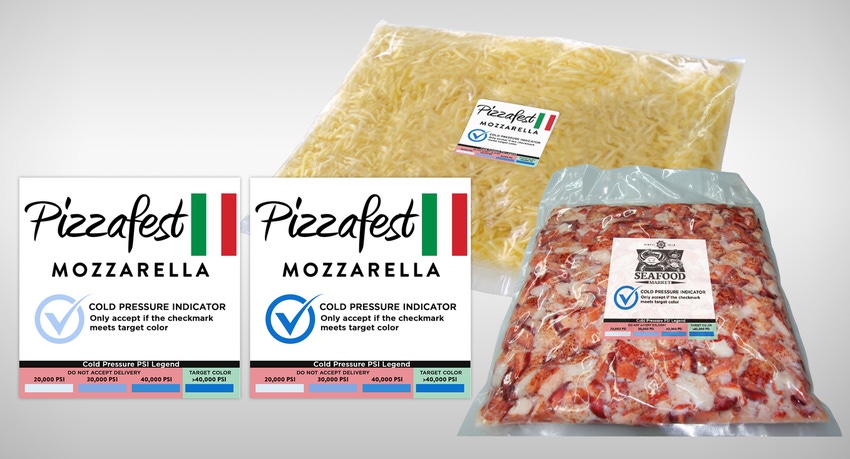New ink verifies that a package has been through high-pressure processing

High-pressure processing (HPP) has become the darling of the food and beverage markets over the last couple years for several good reasons: better product quality and longer shelf life, for example. But, until now, there hasn’t been a clear visual indication that a food or beverage package has been HPP treated. Any packages that slip through the system would cause a serious food safety risk.
Chromatic Technologies Inc. (CTI) has developed a patent-pending, high-pressure indicator “ink” that visually verifies that a package has been through high-pressure processing to kill bacteria in the product. Similar to color-changing inkjet codes printed on food can lids prior to retorting that turn from red to blue to confirm sterilization, the CTI ink appears clear when printed but turns color when exposed to high pressures during HPP.
Currently available in water-based and ultraviolet (UV)-cured inks, CTI’s verification technology is applied to packaging like any conventional ink. According to the company, solvent-based inks will be available in the future if the demand justifies the development expense.
The technology even contains an anti-counterfeiting feature to prevent a dishonest person from printing another mark on packaging and claiming it’s an HPP indicator when it’s not.
Packaging Digest has gained exclusive details on this critical HPP development from Patrick Edson, chief marketing officer at CTI (Chromatic Technologies Inc.).

Patrick Edson
How often do packages mistakenly bypass HPP treatment in a food processing plant? How are these mistakes caught now or what safeguards might already be in place?
Edson: There is no data or audit tool to detect what bypasses an HPP machine. Many of the HPP production processes are manual (move, fill, un-fill, pack, move), so there are a lot of opportunities for confusion or mistakes. The HPP tollers are top-notch and any mistakes as a percentage of what they do are quite small. But there's a famous quality saying, "If you can't measure it, you can't manage it."
Currently, if a pallet mistakenly bypasses the machine or is not processed properly, it becomes a "safety hand-grenade" for the entire business. It's difficult to identify where the problem originated, so you're stuck with two bad choices: (1) under-react by failing to understand if something in your process is responsible or (2) over-react and issue a recall for inventory that has not been impacted.
Adding tools for quality measurement will help mitigate both of those bad options.
Is this HPP verification more to reassure the food manufacturer or the retailer/consumer that the product has properly been processed?
Edson: There are three major groups interesting in using the technology:
1. Brand safety and quality teams. They are blind-monitoring their products at the truck, pallet or individual package level to audit compliance with HPP (“Was a package submitted to high pressure?”) and identify severe heat damage.
2. Restaurant chains. They are receiving large amounts of products sent to their stores under the assumption that everything has been subjected to HPP, but there is no mechanism to confirm an HPP event. The CTI technology makes it easy for a restaurant to identify and quarantine the "hand-grenade" of food safety before it’s served to consumers.
3. Grocery stores. National chains will begin mandating that certain product lines must be HPP processed and provide safety indicators for auditing HPP and heat damage. It improves the quality of the products they sell, extends shelf life, protects consumers and avoids insane costs of product recalls and damaged reputation.
This technology is not designed to be a verification on the proper performance of an HPP machine. HPP machines are expensive equipment with sophisticated monitoring software and protocols. HPP indicator technology is designed to help the shop floor identify what's been through the HPP machine. Floor employees in HPP processing plants need a tool to validate a high-pressure event took place when the basket exits the HPP machine.
Today, many HPP machines place a foam cup in each basket prior to processing. The HPP employee confirms the cup is crushed when the basket of food exits the machine. CTI's HPP indicator technology makes obsolete the need for cup. Current financial models show that if a cup is used for each HPP cycle, the cost of the cup, ordering, labor, inventory and disposal are in the range of $750,000 to $1 million per year. And that's just the cost to monitor the baskets exiting the machine.
HPP indicators handle that function and give information down to the package level and allow it to be tracked all the way to the store shelf.
Why is it important that the CTI patent-pending HPP-indicator technology can differentiate between different pressure exposures (<20,000 psi, 20,000 psi, 30,000 psi and >40,000 psi)?
Edson: HPP indicators can confirm a package has been submitted to 50,000 psi. The purpose of the color differentiation—clear below 20,000 psi and increasing color differentiation at 30,000 psi, 40,000 psi and 50,000 psi—is a built-in quality control mechanism to show that technology is finely tuned and highly sensitive to its environment and is not providing activation at a lower pressure.
How does it distinguish between the various pressures? Is it one ink that shows different gradations of a hues or an ink tailored to the pressure of interest?
Edson: As the pressure increases, it increases chemical interaction with the dye, thus increasing the color.
When do you expect the patent to be issued?
Edson: The first patent issued was in 2015 for pressure activation and verification on a tape applied to a substrate. The current pending patent extends the technology to an on-pack ink vehicle that can be printed like a conventional ink. We expect it to be issued in 2017.
Is the verification ink compliant for food contact by the Food and Drug Administration?
Edson: The HPP technology is FDA-compliant for indirect food contact and is Swiss and EuPia [European Printing Inks Assn.] compliant.
What is in the ink that adds an anti-counterfeiting feature to it?
Edson: We don't disclose the counterfeit mechanism, but we can use the high-heat alerts to differentiate it from “conventional” ink that would-be imitators might attempt.
On what surfaces or substrates can this be used?
Edson: CTI's HPP technology can be printed on all HPP-friendly substrates. If it goes into an HPP machine, CTI's technology can be printed on it (except for an inkjet coding system)
Does this ink have to be surface printed? Why or why not?
Edson: No, laminates as well as surface printing are fine. It should be used with a protective layer or OPV [over print varnish].
When is the HPP verification mark added to the package? Is it printed in-line with the rest of the graphics or on demand on the packaging line just prior to HPP?
Edson: It's printed at the same time as conventional package inks. It's added to the normal printing process as an additional print station in water-based and UV systems (flexo and gravure). A solvent solution is available with appropriate demand commitment.
What printing technology is used to add the ink to the package?
Edson: HPP can be printed in all traditional printing methods: water-based and UV flexo/gravure/EB [electron beam]. It is not compatible with inkjet.
Do you recommend that food processors create a custom code for HPP verification or use standard wording/graphics? Why that?
Edson: HPP indicators will complement current HPP coding. The first step by most companies is to place the technology on the package covertly to understand and audit the supply chain. Once the implementation is well understood, on-package or other communication will be increased to explain the benefits of HPP and enable a "safe check," similar to expiration dates and "keep refrigerated" reminders.
Can this verification be read automatically on the packaging line for high-volume products?
Edson: Yes, the "color check" can be read by a laser for automated "kick out" if the HPP indicator is not activated.
What is the cost of adding this verification to a package?
Edson: Pricing depends on volume, but the additional safety benefit can be added to each package for fractions of one cent.
Do you have any customers using this yet? If so, who, where and for what products?
Edson: The technology was just introduced in December 2016. Since then, CTI has been overwhelmed by the requests for samples, line trials and technical assistance for commercial implementations. We anticipate brands will be using the technology in the next 60 days, but we're bound by confidentiality in all cases.
***********************************************************************************
See a host of new ideas in packaging materials, machinery and more at the new Advanced Design & Manufacturing Cleveland event (Mar. 29-30; Cleveland, OH). Register today!
About the Author(s)
You May Also Like




